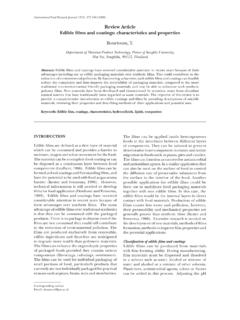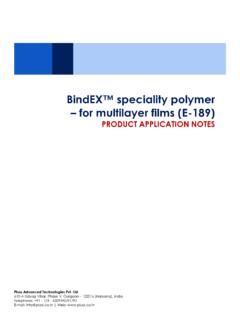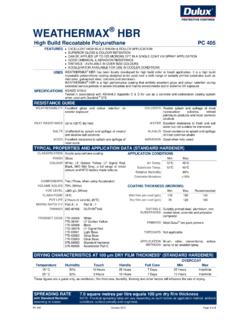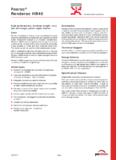Transcription of Microparticles obtained by complex coacervation: influence ...
1 Ci ncia e Tecnologia de Alimentos ISSN 0101-2061. Original Microparticles obtained by complex coacervation : influence of the type of reticulation and the drying process on the release of the core material Micropart culas produzidas por coacerva o complexa: influ ncia do tipo de reticula o e do processo de secagem na libera o do material de recheio Izabela Dutra ALVIM2, Carlos Raimundo Ferreira GROSSO1*. Abstract Microparticles obtained by complex coacervation were crosslinked with glutaraldehyde or with transglutaminase and dried using freeze drying or spray drying . Moist samples presented Encapsulation Efficiency (%EE) higher than 96%. The mean diameters ranged from to m for moist samples, from to m for dried samples, and from to m for rehydrated Microparticles . The integrity of the particles without crosslinking was maintained when freeze drying was used.
2 After spray drying , only crosslinked samples were able to maintain the wall integrity. Microparticles had a round shape and in the case of dried samples rugged walls apparently without cracks were observed. Core distribution inside the particles was multinuclear and homogeneous and core release was evaluated using anhydrous ethanol. Moist particles crosslinked with glutaraldehyde at the concentration of 1 protein (ptn), were more efficient with respect to the core retention compared to 1 ptn or those crosslinked with transglutaminase (10 1 ptn). The drying processes had a strong influence on the core release profile reducing the amount released to all dry samples. Keywords: complex coacervation ; transglutaminase; glutaraldehyde; controlled release. Resumo Micropart culas produzidas por coacerva o complexa foram reticuladas com glutaralde do ou com transglutaminase e secas por liofiliza o ou por spray drying .
3 As amostras midas apresentaram Efici ncia de Encapsula o (%EE) maior que 96%. Os di metros m dios variaram de 43,7 3,4 a 96,4 10,3 m para amostras midas, de 38,1 5,36 a 65,2 16,1 m para as amostras desidratadas e de 62,5 7,5 a 106,9 26,1 m para as amostras reidratadas. A integridade das part culas sem reticula o foi mantida quando a liofiliza o foi utilizada. Ap s a secagem por spray drying , apenas amostras reticuladas mantiveram a integridade da parede. As micropart culas apresentaram forma esf rica e no caso das amostras desidratadas, paredes rugosas aparentemente sem rachaduras foram observadas. A distribui o do recheio nas matrizes foi multinucleada e homog nea e a libera o do material de recheio foi avaliada em etanol anidro. Part culas midas reticuladas com glutaralde do na concentra o de 1,0 1 de prote na foram mais eficientes na reten o do recheio comparadas a 0,1 1 de prote na ou reticuladas com transglutaminase (10 1 de prote na).
4 A secagem influiu fortemente no perfil de libera o do recheio, reduzindo a quantidade liberada para todas as amostras secas. Palavras-chave: coacerva o complexa; transglutaminase; glutaralde do; libera o controlada. 1 Introduction Microencapsulation is a technology to coat substances a barrier, thereby allowing its encapsulation (TOLSTOGUZOV, with a material that isolates and protects them from the 1991; SCHMITT et al., 1998). Biopolymers which fit for environment. In addition to the protection effect, the controlled coacervation , have hydrophilic colloidal properties; solubility release may be obtained (THIES, 1995). Microencapsulation in aqueous medium; and adequate charge density and linear by coacervation has been used by some industrial segments chains (VANDERGAER, 1974). such as pharmaceutical, food, chemical, and cosmetics for the Properties such as mechanical and thermal resistance and controlled release of several types of cores such as flavors, drugs, permeability/release of the coacervated microparticle wall and paints with a wide range of applications (SCHMITT et al.)
5 , may be altered by crosslinking using chemical or enzymatic 1998; KRUIF; WEINBRECK; VRIES, 2004). compounds (BURGESS; PONSART, 1998; LAMPRECHT;. complex coacervation is mainly used to microencapsulate SH FFER; LEHR, 2000; KRUIF; WEINBRECK; VRIES, 2004). hydrophobic substances and is based on the interaction among Glutaraldehyde is a chemical agent used in protein crosslinking, different polymers with opposite charges. This interaction and promotes covalent binding between amino groups. This type forms insoluble complexes and produces phase separation. The of crosslinking is irreversible and resistant to extreme conditions deposition of such complexes around a hydrophobic core creates of pH and temperature (BEPPU; ARRUDA; SANTANA, 1999;. Recebido para publica o em 26/1/2009. Aceito para publica o em 26/6/2009 (004047). 1. Departamento de Alimentos e Nutri o, Faculdade de Engenharia de Alimentos, Universidade Estadual de Campinas Unicamp, CEP 13083-862, Campinas - SP, Brasil, E-mail: 2.
6 Departamento de Tecnologia de Cereais e Chocolates, Cereal Chocotec, Instituto de Tecnologia de Alimentos ITAL, CEP 13070-178, Campinas - SP, Brasil *A quem a correspond ncia deve ser enviada Ci nc. Tecnol. Aliment., Campinas, 30(4): 1069-1076, 2010 1069. Microparticles obtained by complex coacervation : effect of reticulation MWANGI; OFNER, 2004). However, glutaraldehyde presents Crossliking and drying of the coacervated Microparticles high toxicity and this precludes its use in food products For crosslinking with glutaraldehyde, the concentrations (VANDELLI et al., 2001). Transglutaminase is an enzyme evaluated ( or 1 ptn) were added to the suspension that promotes crosslinking among proteins resulting in the of coacervated particles and the system was maintained under formation of intra and intermolecular -( -glutamyl) lysine slow magnetic stirring.
7 For transglutaminase, the amount of bonds (MOTOKI; SEGURO, 1998). enzyme used was 10 U per gram of protein, initially solubilized with deionized water; the pH was adjusted for and added drying coacervated Microparticles may extend their shelf- to the particle suspension, maintaining the system under slow life and also extend its usage in dehydrated products (BURGESS; stirring. The crosslinking reaction time was 18 hours at room PONSART, 1998). Freeze drying , oven drying , water removal temperature (23 2 C). After the reaction period, the moist with solvents and drying under room conditions may be used particles were sieved ( 25 m) and washed three times with to obtain dehydrated coacervated Microparticles . However, deionized water (pH ). A portion of the material (with most of these methods can cause the disintegration of the wall and without crosslinking) was freeze-dried (501, Edwards, during drying , which may interfere with the size of the particle UK); initial temperature: 40 C, Pressure: mmHg, final and with core release properties (THIES, 1995; BURGESS; temperature: 25 C/2 hours, total cycle time, 48 hours) and PONSART, 1998).
8 Spray drying of Microparticles may produce stored in a refrigerator. The second portion of the material individual particles, but the low physical strength of the wall (with and without crosslinking) was submitted to spray drying and the conditions used in this process may limit the use of this (SD-05, Lab-Plant, UK) as an aqueous suspension of coacervated method (BURGESS; PONSART, 1998). particles; inlet temperature: 225 C and outlet temperature: 125 C, as determined in preliminary experiments. The objective of this work was to obtain Microparticles by complex coacervation using a mixture of paprika oleoresin Characterization of the coacervated Microparticles and soybean oil as core crosslinked with glutaraldehyde or transglutaminase, freeze dried, or spray dried, and Mean diameter and size distribution of the particles then to evaluate the crosslinking and drying effects on the morphological characteristics, microparticle size, and on the The mean diameter ( m) of the coacervated Microparticles , release of the hydrophobic core.
9 With or without cross-linking, moist or dried, was determined by measuring the diameters of at least 150 particles from the images formed in an optical microscope (Olympus, Japan) and 2 Material and methods captured using a digital camera controlled by the Global Lab Image program, followed by the analysis of the digitalized photos Material using the free Scion Image program ( ). For moist and rehydrated Microparticles , the images were captured The following materials were used: bovine type B gelatin on water and for dried particles in glycerol. (bloom = 270 g, of protein) donated by Gelita South America (S o Paulo, Brazil), gum Arabic (batch 30841, Synth, S o Paulo, Brazil), soybean oil Liza, paprika oleoresin Citromax Morphology (Garulhos, S o Paulo, Brazil), anhydrous ethanol (99%, Chemco, An optical microscope (eclipse E800, Nikon, Japan) and S o Paulo, Brazil), glutaraldehyde (25% v/v, Nuclear, S o the Image Pro Plus software were used to obtain images Paulo, Brazil), transglutaminase of microbial origin donated from moist particles.
10 For dried particles, Scanning Electron by Ajinomoto (Activa TG-S , S o Paulo, Brazil), with activity Microscopy (SEM) was used. The samples were fixed in stubs of 100 1 solid, as informed by the manufacturer. using double-faced copper adhesive tape and coated with a thin layer of gold in a Balzer Sputter (SCD50, Baltec, Liechtensten). for 75 seconds using a current of 400 mA. The samples were Encapsulation procedure subsequently observed (JMS-T300, Jeol, Japan) with voltage Coacervated Microparticles were produced according to acceleration of 10 kV. Thies (1995) and Lamprecht, Sh fer and Lehr (2000), with modifications. A mixture of paprika oleoresin and soybean oil Encapsulation efficiency (1:1), 5 g, was emulsified with 100 mL of gelatin solution ( Encapsulation efficiency (EE%) was calculated using the w/w, 45 3 C) using an Ultra-Turrax homogenizer (T18, Ika, following Equation 1: Germany), 14,000 rpm for 3 minutes.















